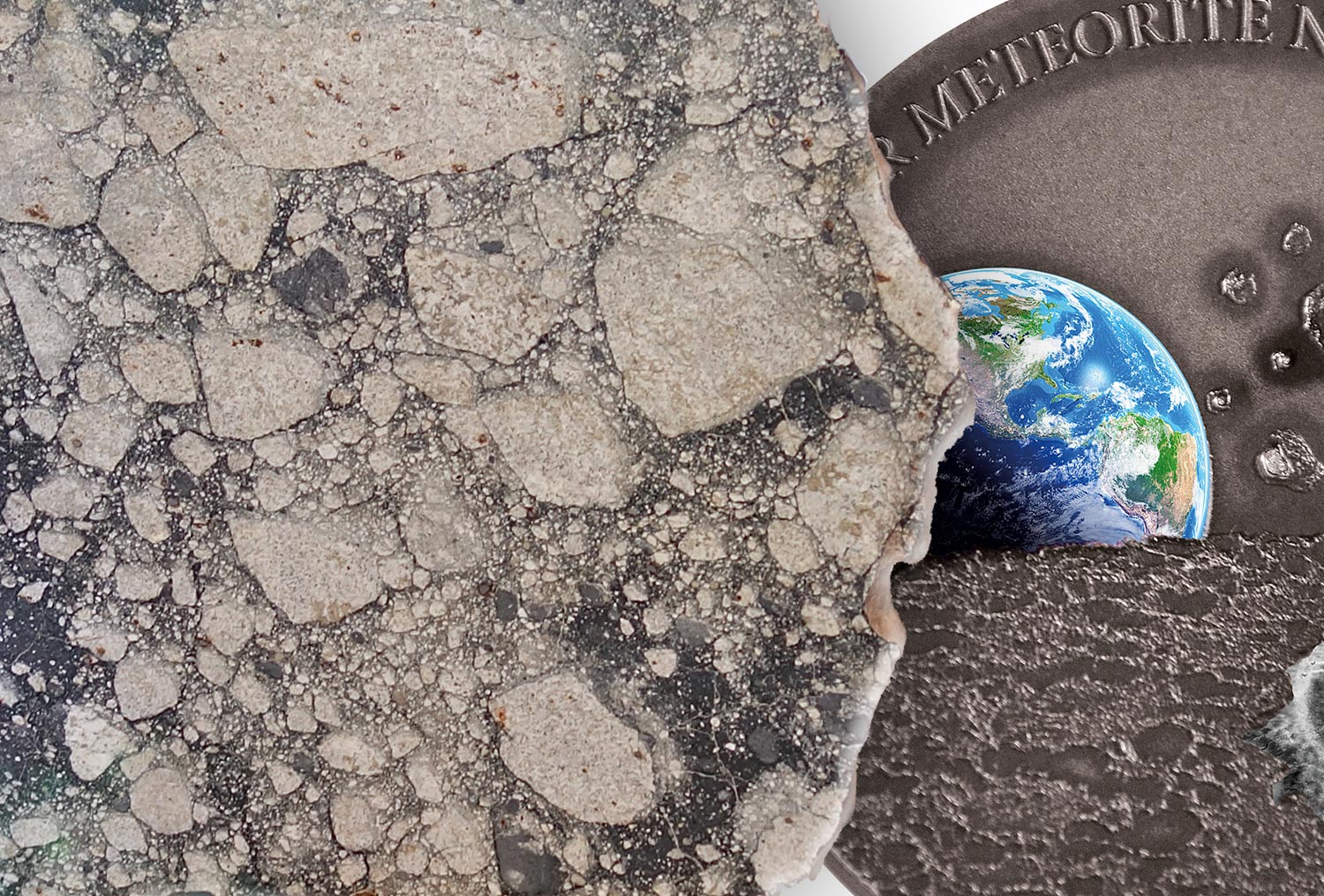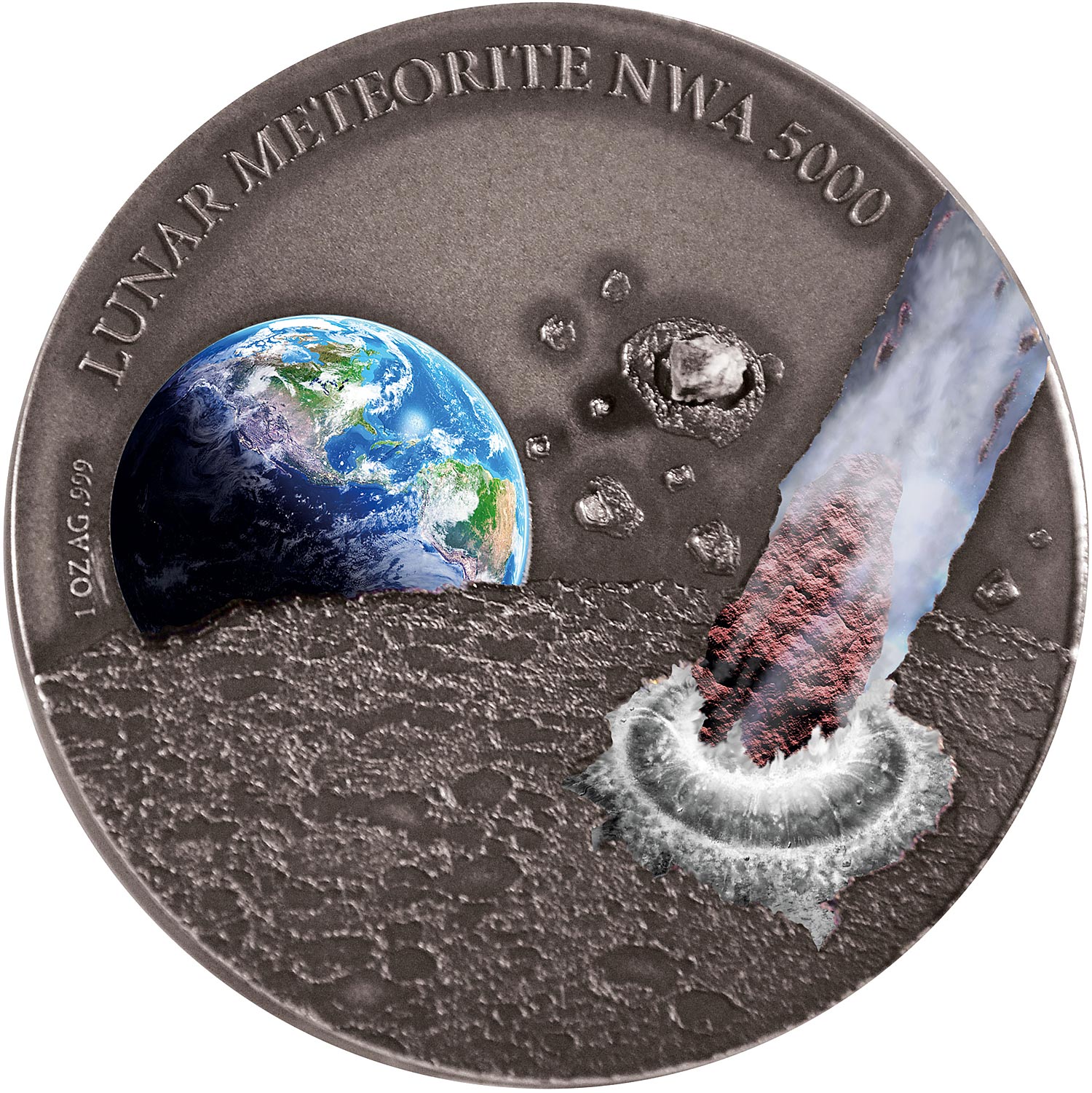Meteorite coins have become a very popular genre of coins over the last decade, with early examples now fetching serious money, easily ten times the issue price. Virtually always silver coins, they’re distinguished by incorporating a piece of an actual specific meteorite within the design. Three coin producers in particular have been popularising these designs, the Liechtenstein-based Coin Invest Trust, the Mint of Poland, and more recently the German producer, MCI-Mint.
MCI-Mint’s first coin, Campo del Cielo, was very similar to the Mint of Poland’s effort depicting Wolfe Creek, but MCI added a couple of nice touches to differentiate its coin, including a coloured flaming tail coming off the back of the fragment to suggest movement. The rear of the coin, while still antique-finished, had the background around the Queens effigy gilded with red gold. This new coin takes that a bit further with some more extensive colouration, mainly a depiction of the Earth and of a meteorite hitting the surface of the moon. The actual piece of metorite is just to the right of the Earth. The antique finish is getting to be a standard for many of these coins, and MCI have always been a firm proponent of the look, and very good at it. The almost lunar surface look of the obverse around the Queens effigy is a nice touch as well.
Limited to only 500 pieces, slightly less even than the 576 of the first coin, it comes with a serialised certificate and in a wooden box. Shipping later this month for around €200, this is a nice addition to the subject. Available to order now.
MINTS DESCRIPTION
There are some science fiction novels and movies sketching a frightening scenario: What if the moon would fall from sky to the earth? But the moon is already falling to Earth. Piecemeal. And since hundreds of millions of years.The vast majority of meteorites falling down on Earth are relics from the time our solar system came into being. Not all of the matter agglomerated into planets and moons; many big and small chunks remained, filling the asteroid belt between Mars and Jupiter or racing through our solar system until they hit another celestial body, for instance the earth or the moon of our earth.
In the last case interesting things could happen. Because of the low gravity the moon has and because of the fact that he has no atmosphere many debris of the impact are hurled into space. They themselves begin a life as meteorites. Many of these pieces afterwards fall to Earth; if they do not burn up during their travel through earthly atmosphere they have the real chance someday to be found by an eager meteorite collector.
When the astronauts of the Apollo 11 mission brought back the first samples of moon rock in the year 1969 nobody suspected how much of the moon already came to our home planet in times before in a natural way. Sure – with 328.00 kg the american moon travellers of the Apollo program are on the winning road regarding the amount of collected moon rock. In contrast, until today 53 officially approved moon meteorites were found on Earth with a total mass of barely more than 28.00 kg. But nobody knows how many hundreds of kilogram moon rock may still lying somewhere on the planet.Since the discovery that one can exchange money not only for goods but also collect it, maybe because of the beauty of a coin, because one wants to learn something more about the world or because one hopes that the collected coins one day will increase in value, since these time a lot of collector coins were produced depicting all possible themes. So in the last years a whole bunch of meteorite coins were issued, but now this special moon meteorite coin which is a rarity because of the tiny, but rare and expensive splinter of real moon rock – one single gram of this meteorite has an approximate market value of 800.00 Euro, more or less!
The splinter is a piece of moon meteorite NWA 5,000. This meteorite is the biggest chunk of moon rock ever found on earth and once had a weight of proud 11.53 kg. It was found in the year 2007 in Morocco, a country which is a paradise for meteorite hunters, because on the sandy ground of the Sahara desert they have exceptional good chances to track down the visitors from outer space.The coin made of one ounce of fine silver is a rarity too because of its small mintage of only 500 pieces. In every case this beautiful coin, which for sure will be liked by coin and meteorite collectors equally, is a worthy resting place for the visitors from space after their long and restless flight through universe.
ADVERTISEMENTS










Where does this meteorite coin are sold at? Where I can buy this Lunar Meteorite coins?